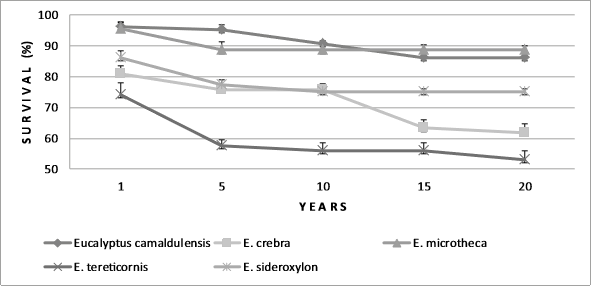Introduction
The current need for wood supplies far beyond the amount available from native forests has led interest in establishing non-native species plantations in many places around the world, particularly in the tropics and subtropics (Malan, 2005). The national and international markets have been increasingly demanding higher amounts and better quality of primary forest products (Botman, 2010). Thus, there is a need to complement the present system of the use of natural forests with commercial forest plantations managed with sustainable criteria. This form of production would supply the forest industry with prime materials from land with greater suitability, reducing the present pressure due to the use and exploitation of the continuous decreasing and deteriorating natural forests (Brown, Gillespie and Lugo, 1991; du Toit, Smith, Little, Boreham and Pallet, 2010).
Worldwide awareness on the importance of forestry in the rural area has pressured governments to achieve useful results in the short term (Tewari, Harris, Harsh, Cadoret y Pasiecznik, 2000; Bustillos-Herrera, Valdez, Aldrete and González, 2007), thus, the cultivation of native and introduced tree species for nonindustrial use have become an important issue, especially in developing countries. In Mexico, forest production for pulp and paper declined from 1190 million of cubic meters in 1995 to 0.976 million of cubic meters in 2015. However, thanks to reforestation programs, the production of fuel increased from 0.242 million of cubic meters to 0.672 million of cubic meters from 1995 to 2015 (Gobierno de los Estados Unidos Mexicanos, 2015).
Eucalyptus is the general name given to the Myrtaceae-Eucalyptus species endemic to Australia and nearby islands. Despite the existence of approximately 600 species of eucalyptus trees, this study is focused only on those species that are particular employed for fuelwood production, such as those analyzed in this investigation. Because of their fast-growing habit, short rotation, high tolerance to desiccation, drought and waterlogging, fast climate adaptation and broad use with high economic benefits, eucalyptus have been placed within the three major fast-growing arboreal species of the world which have become widespread in tropical and subtropical regions (Maydel Von, 1996; Chen, 2005).
Since the seventies, the native forests of northeastern Mexico have undergone a great deal of destruction, mainly due to land-clearing and the lack of appropriate technologies for the improvement of natural resources of these regions (Gonzalez et al., 2010; Heiseke and Foroughbakhch, 1985). Hence, the inadequate exploitation practices of forest management in the region have resulted in a severe degradation over large areas that have altered forest structure and plant communities, especially those inhabited by native vegetation. Thus, we believe that the data gathered in this work is important to plan strategies to recover those ecosystems which have been degraded by human activities. In this sense, we have noticed in person that a series of plots of various Eucalyptus species planted around the country between 1950 and 1961for different purposes have still survived to this day. Hence, the use of Eucalyptus species for plantations in semiarid regions might be a suitable choice for the restoration of degraded areas which, in turn, may be managed to produce timber and fuelwood.
Furthermore, the common practice of planting of tall trees like eucalyptus to reduce the speed of winds along with other tree species, grasses, etc., will bind the soil, make it more compact and prevent desertification (Fearnside, 1990; Gadgil and Guha, 1993). Forest projects in combination with agroforestry systems employing eucalyptus trees (Andrade, García, Couto and Pereira, 2001; Dube et al., 2002; Valeet al., 2004) have been useful in the preservation of the ecological balance and the absorption of carbon dioxide, which is suggested to increase the temperature of the atmosphere (Bucur, 2006; Caparrós, Cerdá, Ovando and Campos, 2010). The quality of crops and pasture in the understory of trees growing in such systems may be improved or reduced depending on the requirements and the effects of those trees on nutrient, moisture, light transmittance and other effects (Ares, Louis and Brauer, 2003; Guevara-Escobar, Kemp, Mackay and Hodgson, 2007). It has been observed that even honey production can be increased in the neighborhood of eucalyptus plantations (Jackson and Ash, 1998). In rural zones of northeastern Mexico, eucalyptus has been mainly used as fuelwood and manufacture of fence and poles. Its wood density is high, so it is suitable for making charcoal. It is also proper for making hard board panels. Leaves from several species of eucalyptus are used as forage and distilled for essential oils.
Objectives
A 20 year term field experiment was conducted to determine the survival, growth and fuelwood volume yield in a pure plantation of five eucalyptus species planted on a degraded land area in northeastern Mexico which could set up suitable strategies for land use in zones alike under semiarid subtropical climate conditions.
Materials and methods
Description of the study área
The experimental area was located on the plains at 400 m altitude in the piedmont of the Sierra Madre Oriental in Mexico (24° 47’ North latitude and 99° 32’ West longitude). In the scheme of Köppen modified by García (2004) the regional climate is defined as semiarid and subhumid [(A)C(Wo)] with two rainy seasons (summer and autumn) and a dry spell between November and April. Mean annual precipitation is 780 mm while mean annual temperature is 22.3 ºC, with a large difference between winter (12 °C) and summer (45 °C) and even within the same month. Hail storms and frosts frequently occur each year during winter even after the beginning of the growing season in March. The water budget is unbalanced, the ratio of precipitation to free evaporation is 0.48 and precipitation to potential evaporation is 0.62. Potential evapotranspiration (PET) estimated by the Thornthwait method is 1150 mm (Návar, Mendez, Graciano, Dale and Parresol, 2004). Most soils of the region are of rocky type of Upper Cretaceous calcite and dolomite. The dominant soils are deep, dark grey, lime-clay vertisols which are the result of alluvial and colluvial processes (Food and Agriculture Organization of United Nation [FAO], 1974), characterized by high clay and calcium carbonate concentration (pH 7 to pH 8) and low organic matter content with low phosphorus and nitrogen content. Vegetation of the study area may be described as dense (2.0 shrubs m-2 to 6.4 shrubs m-2), shrubby (average height of 1.95 m to 2.63 m) and diverse. Most plant species overlap vertically from 0.5 m to 5.0 m. Horizontal average distance between shrubby stems is 30 cm while mean crown radius is 47 cm resulting in a mean overlapping extent of 17 cm (De Soyza, Whitford, Martínez-Meza and Van Zee, 1997; FAO, 2003).
Species selection
The species to be planted were selected considering their adaptability to the regional climate, growth rate and potential use by the local human population as timber for construction assembly and fuelwood (Foroughbakhch et al., 2006). Furthermore, general utility species combine adequate morphological shape with structural strength and durability. Besides, trees for high-quality craftsmanship were selected for their combination of beauty, working properties and stability. Thus, five non-native species of eucalyptus were considered. Table 1 shows information about the name, family and wood characteristics of each of the selected species.
Table 1 Characteristics, life form and uses of five Eucalyptus plant species selected for study.
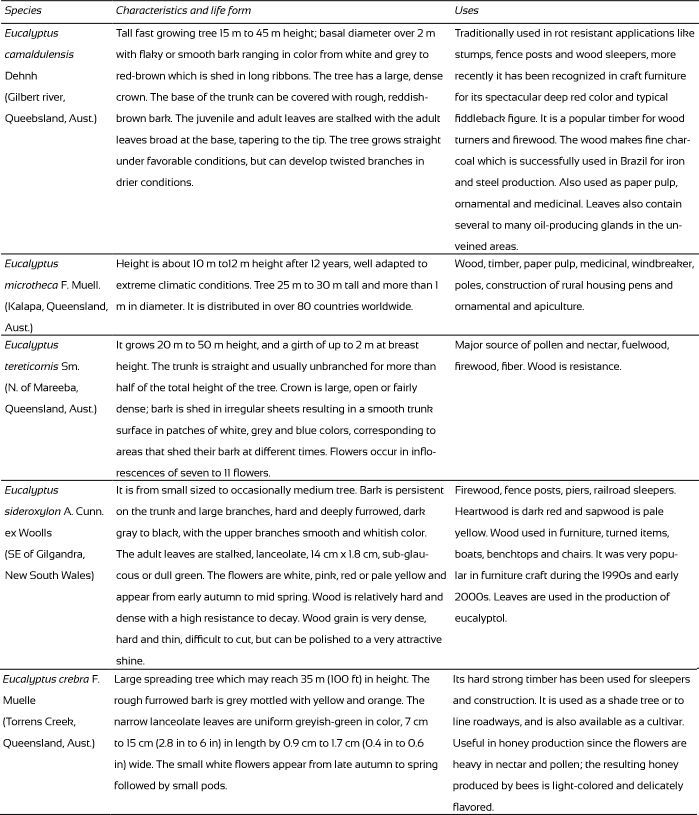
Source: Berni, Bolza and Christensen (1979), Niembro-Rocas (1990).
Seedling production
Seedlings were produced from seeds imported from Australia and selected by the Commonwealth Scientific and Industrial Research Organization [Csiro] and the FAO for the edaphic and climatic conditions of northeastern Mexico.
Wooden boxes (80 cm × 45 cm × 8 cm) in a greenhouse were used as germination trays filled with 2.5 cm depth of a 1:1 mix of vertisol and river sand, and watered for sowing. Before use, the mix was sterilized on a galvanized iron sheet over fire for 45 min to 60 min. Seeds were sprinkled evenly over the surface of the trays using a metal container with scattered punched holes to avoid sowing too densely. Sowing recommendations from Csiro were followed to produce more than 1000 healthy seedlings per tray, from which the healthiest 500 to 750 were subsequently removed and transplanted. Although some assays were carried out to improve germination, no pre-treatment was applied to seeds since most Eucalyptus species germinate readily (Kleinig and Doran, 1981). After 10 days to 14 days of sowing, germination was widespread for all species. After six weeks seedlings were transplanted into 7.5 cm × 12.5 cm polyethylene bags filled with a mix of vertisol, litosol and river sand at a ratio of 1:1:1 and shaded for two weeks after transplanting. Afterward, they grew in full sunlight. Water was frequently applied up to soil saturation.
Experimental design and cultural Works
Four months later, when plants reached an average height of 20 cm they were planted in plots of 21 m × 21 m under a completely randomized design, with four replicates per species over a plain area. Each plot contained 49 plants planted in 3 m × 3 m spacing (1111 plants ha-1) with 2 m separation between plots and with a bushy strip as wind protection around the whole experimental area (Underwood, 2004). Only 25 trees species-1 taken from the internal rows in each plot were used for analysis.
At the second year, all branches were pruned from the lower third of the trees. Weed control and cleaning was undertaken when required. Life-saving irrigation was provided during the first year of establishment to ensure adequate survival of seedlings.
Data collection
Data collection on growth parameters were realized according to Foroughbakhch, Hernández-Piñero and Carrillo-Parra (2014) by measuring the following variables: survival, height increment, basal diameter and fuelwood volume (V). Crown surface area (C) was also determined (Mueller-Dombois and Ellinberg 1974). Measuring of these parameters (except fuelwood volume) was registered every five years since 1995. The fuelwood volume was determined at 15 and 20 years after plantation. The volume of suitable commercial size for fuelwood or constructions was calculated using the Smalian equation, with a 0.6 of morphic coefficient factor (Meskimen and Franklin, 1979):
where D1 and D2 are the diameters of each end (m) and L is the length of the section (m).
The total tree volume (in m3) was calculated based on their commercial height and diameters multiplied by the species density per hectare.
Statistical analysis
Mean values and standard errors were calculated for each species according to Zar (2010). One way analysis of variance (ANOVA) was performed to determine differences between the estimated growth and the production parameters of the species (Panse and Sukhatme, 1995). Simple linear regression models were applied to detect differences between crown size mean, height and basal diameter. Contrast essays were applied to compare the mean values of fuelwood production (Hinkelmann and Kempthorne, 1994) with the help of the statistical package SPSS (v. 21.0). Least significant differences were calculated at 5% probability level.
Results
Survival
Survival of each species was evaluated at the end of each five vegetative periods. Results indicated that except for E. tereticornis (53.0%) and E. crebra (61.8%) all other species showed a minimum of 75% survivorship at age 20 years (Fig. 1). E. microtheca and E. camaldulensis were the most suitable of the established species, with 86% to 88% survival respectively. The capacity for ready establishment confers to both species their aggressive characteristics in the invasion of pastures and fallow land. Furthermore, some non-native species of Eucalyptus, such as E. camaldulensis and E. microtheca, have already replaced certain local species by the occurrence of natural regeneration within the experimental plots (Carstens, 1987). Eucalyptus species play a negative role on the forage quantity and quality under trees.
Height and diameter increment
Plant height and diameter increment values, along with survival, are valid criteria to evaluate the development of woody species for forestry programs and worthy indicators of the site conditions. However, they are also dependent on some other factors such as interspecific competition, standard density (spacing) and climatic conditions. This latter factor seems to determine the growth and development of the studied species in northeastern Mexico. In the present experiment the five selected species showed high variability in current annual increment (CAI) as much in height as in basal diameter during different time periods (Fig. 2 and Fig. 3). Most species had a rather constant increment in mean tree height and diameter. One reason for the continuing increment is that the shorter and most suppressed trees were gradually dying with a consequence that the resulting mean height and diameter increased, despite largest trees were growing in a lesser extent. The mean height and diameter of E. camaldulensis and E. tereticornis was developing faster between 10 and 15 years, and thereafter becoming slower than the other species.
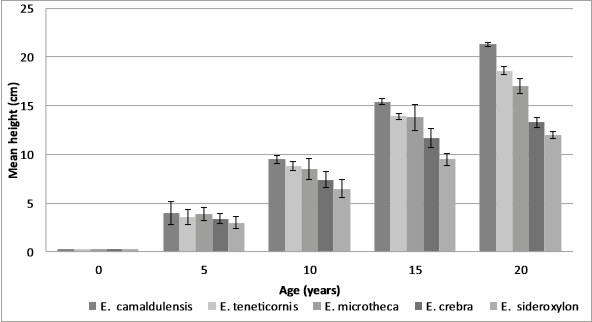
Figure 2 Current annual increment (CAI) in height (m) of five Eucalyptus species during different time periods.
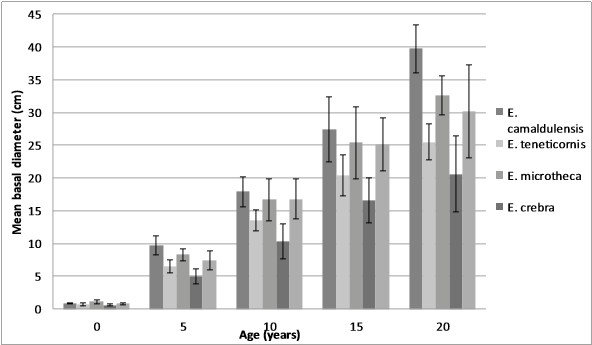
Figure 3 Current annual increment (CAI) in basal diameter (cm) of five Eucalyptus species growing in semiarid conditions.
Table 2 shows the results of the analysis of variance on the height increase in different plant species accordingly to their ages at the time of measuring in different plots. Highly significant differences (P = 0.00) were observed in species heights at different ages but no statistical differences were observed within or between plots (P > 0.05).
E. camaldulensis with 1.08 m mean annual height increment (mah) and 1.89 cm mean annual basal diameter increment (mabd); E. tereticornis (0.94 m mah; 1.36 cm mabd) and E. microtheca (0.94 m mah; 1.65 cm mabd) showed a high growth potential from the moment of plantation but also, as other species, suffered height reductions due to winter frosts in 1985 (-8 °C) and 1989 (-5 °C). However, their susceptibility to low temperatures does not limit their use as a forest tree in northeastern Mexico. Instead, their rapid regrowth makes them suitable for forestry purposes.
Based on the results of analysis of variance (Table 3), basal diameter both between species and within plots were highly significant (P < 0.01) in different measurement dates. The significant difference within plots is most probably due to interspecific competition between plants of the same plot as a result of the high density of plants (1111 plants ha-1), and the fact that the productive capacity of the forest area (the relationship between the dominant height and age) was not homogeneous since the land is used more for livestock than forestry.
Eucalyptus crebra (0.79 m mah; 1.04 cm mabd) and E. sideroxylon (0.63 m mah; 1.51 cm mabd) had low growth rates compared with E. camaldulensis and E. microtheca but higher than the natural vegetation (0.13 m - 0.24 m mah; 0.2 m - 0.4 cm mabd). Diameter growth of E. camaldulensis, E. tereticornis and, E. microtheca occurred concomitantly to the height growth, thus these species developed faster than other species during the first 15 years.
Most species had a moderately constant increment in mean tree height and diameter. One reason for the continuing increment is that the smallest and most suppressed trees of some species, such as E. crebra and E. sideroxylon, were gradually dying with a consequent mean diameter increase, although the largest trees were growing less.
E. camaldulensis had by far the highest mean annual increment (MAI) with a maximum of 1.2 m attained at 15 years of age maintaining it subsequently. Other species showed a similar trend but with lower MAI values. E. microtheca also had high MAI values with 1.16 m at 15 years but decreasing thereafter. E. crebra and E. sideroxylon showed a different path with a slower MAI during young ages and the highest MAI of 0.86 m and 0.70 m respectively at 15 years and 20 years.
Crown development
Since wood and firewood production is normally a function of height and crown size it is more convenient that the lateral branches grew faster than the central apex in multipurpose trees. This growth habit gives rise to a broad dispersed canopy, especially in poor or dry sites (Ramovs and Roberts, 2003; Burley, 1980).
Larger mean crown area and crown length were observed in E. tereticornis (21.45 m2 ± 2.24 m2; 4.13 m) and E. microtheca (19.60 m2 ± 1.11 m2; 3.31 m). The smaller mean crown area was presented in E. crebra (15.84 m2 ± 0.4 m2; 2.86 m). Thus, all the tree species, except E. crebra, established and performed suitably (Table 4).
Table 4 Crown projection of five Eucalyptus species (20 years after planting) in Mexico.
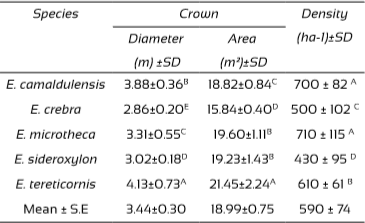
*S.D. = Standard Deviation. Values in columns with different superscripts differ (p < 0.05).
Eucalyptus tereticornis, E. microtheca and E. camaldulensis demonstrated a good capacity for early crown expansion in comparison to the E. crebra. However, if these species have heterogeneous growth rates, the growth of slow-growing trees may be inhibited by the aggressive crown expansion of faster-growing species in mixed stands.
Assays on the development and environmental responses on selected tree species have commonly accepted diverse criteria such as survivorship, growth in height, crown diameter and projection of foliage cover, and wood volume, which suggest that each species has unique aspects of growth potential. Analysis of the relationship between variables helps to highlight these characteristics. It is shown in Table 5 the coefficient of correlation (r) between crown, height and basal diameter after fifteen and twenty years of establishment. Eucalyptus camaldulensis (r = 0.78-0.83), E. sideroxylon (r = 0.83-0.88) and E. tereticornis (r = 0.72-0.84) showed a high correlation between crown, height and basal diameter for both growth periods which confirm their great potential for biomass production in the field and elsewhere. This is the result of their rapid growth in basal diameter in correlation with their rapid crown expansion, as obtained by Djogo (2001).
Wood volume determination
Data on volume growth indicated that under plantation conditions, E. camaldulensis (2.93 m3 ha-1 yr-1), E. tereticornis (2.71 m3 ha-1 yr-1) and E. microtheca (2.60 m3 ha-1 yr-1) demonstrated a relative high production both per hectare and per tree, with a population density between 610 trees ha-1 and 700 trees ha-1 (Table 6).
Table 6 Wood volume production and current annual volume increment (CAVI) of five eucalyptus trees at age 15 and 20 in the semiarid regions of Mexico.
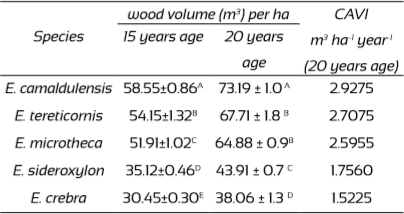
*S.D. = Standard Deviation; Values in columns with different superscripts differ (p < 0.05).
Based on stem volume tree-1 E. sideroxylon produced only 0.0816 m3 throughout the period 1985-2005, a quantity similar than E. camaldulensis (0.0836 m3) and E. tereticornis (0.0888 m3) but higher than the quantity produced by any native woody tree, which varied from 0.0103 m3 plant-1 for Acacia schaffneri to 0.0207m3 plant-1 for Prosopis laevigata according to Foroughbakhch et al. (2012).
The results indicate that the wood volume output, even in early stages, is high for most of the studied species compared to E. crebra. Thus, a fast initial growth in height and diameter is occurring in these species. It must also be mentioned that both planting density and survival clearly influence the volume and productivity of the stands.
Discussion
Eucalyptus plantations are easily established and fast growing, and can be highly profitable, even in semiarid areas that are traditionally poor in timber production. However, there are also negative environmental impacts (hydric and allelopathic) in planting Eucalyptus, such as loss of biodiversity in the understory and soil degradation (Forrester, Bauhus, Cowie and Vanclay, 2006; Gareca, Martinez, Bustamante, Aguirre and Siles, 2007; Wang, Lencinas, Friedman, Wang and Qiu, 2010). According to Zhang and Fu (2009), there are four ecological processes by which allelopathic chemicals are released into the environment, namely volatilization, leaching, foliage litter decomposition and root exudation. In our experiment the last two phenomena negatively affected the establishment and development of herbaceous and native plants. Thus, it is important to search for native species with a high tolerance to the allelopathic effects of Eucalyptus (Sasikumar, Vijayalakshmi and Parthiban, 2001).
The stand density values varied as the trees matured among species (from 430 trees ha-1 for E. sideroxylon to 710 trees ha-1 for E. microtheca). The high initial plant density (1111 trees ha-1) notably influenced the growth in height and diameter of all species during the first stage of development (1-3 years). Faulty plantation, defoliation by ants combined with browsing by jack rabbits (Lepus californicus), summer droughts, and winter frosts were observed factors that seem to contribute importantly to the initial mortality rate. Despite most of the species employed in this study usually developed a broad disperse crown when mature, growth in tree diameter was mainly affected by the stocking density in the early development. At early stages crown competition did not develop yet in the plantation, although competition at the rhizosphere might have been intense. According to Soares and Tomé (2001, 2002), the initial stocking of some plantations ( > 1100 stems ha-1) have been considered excessive since in silvicultural management less than 700 plants ha-1for plantation of eucalyptus is recommended.
Stem basal growth also differed among species at all age intervals. E. camaldulensis (1.99 cm year-1 ± 0.5 cm year-1) followed by E. microtheca (1.63 cm year-1 ± 0 .8 cm year-1) had the greatest stem girth at the ages of 15 years and 20 years, and both tree species were significantly superior to the rest of the tree species. On the contrary, among the five eucalyptus species tested, E. crebra (1.03 cm year-1 ± 0.3 cm year-1) had the thinner stems. These results were in accordance to Borough, Incoll, May and Bird (1984) who indicated a mean basal diameter of 26.5 cm and a mean basal area of 40.9 m2 ha−1 for a nearly 29 year old untinned E. grandis stand in an experiment in New South Wales, Australia.
The results of this study indicate that the main factors affecting stand development of the eucalypt plantations are the length of drought periods (during December to March and August to September), soil type and low temperature (up to -3 °C in February 1988 and March 1995). These findings are consistent with those of other studies carried out in Australia by Cromer (1996) and in Portugal by Fabião at al. (1995) stating that tree growth is mainly limited by the availability of water, being nutrient availability an additional factor. In the present study, the unsatisfactory productivity of the plantations in the early stage of establishment (comparing to the tropical eucalyptus trees) can therefore be explained by the length of the drought period in winter and early spring and the low temperatures and frost in winter.
Rathert and Werasopon (1993) found that environmental conditions such as soil characteristics, rainfall and altitude are very influential to growth. The maximum growth observed in E. camaldulensis and the minimum growth in E. crebra in terms of height and stem girth may be due to their inherent fast and slow growing habits respectively. In fact, the lower height in E. sideroxylon and E. crebra may be due to insect (ants) and jack rabbit attacks since the plantation was heavily infested during the first two years of the experiment.
The wood and fence production situation in developing countries can be improved by the planting of more trees and better management of existing forest resources (Semana, Bawagan, Sirimban and Mendoza, 1977). In semi-arid zones fuelwood planting may use native and non-native species with multiples trunks or wood that warps or splits as it dries. Thus, eucalyptus species may prove satisfactory for village fuelwood, posts and timber, if it grows fast and produces a dense wood that burns with intense heat, according to Dávalos and Bárcenas (1999).
E. camaldulensis (3 m3 ha-1 year-1), E. tereticornis (2.8 m3 ha-1 year-1) and E. microtheca (2.6 m3 ha-1 year-1) have the relatively high-volume growth in comparison to E. sideroxylon (1.8 m3 ha-1 year-1) and E. crebra (1.5 m3 ha-1 year-1). These species grew relatively fast at young ages, and it continued growing for the whole 20 year period. These results for wood volume are far below those results obtained by FAO (2006) on the planted forest database (PFDB) with maximum mean annual growth rates of 35 m3 ha-1 year-1 for E. grandis; 21.5 m3 ha-1 year-1 for E. camaldulensis in tropical zones (FAO, 2003). Heiseke and Foroughbakhch (1985) have registered values of wood production less than 1 m3 ha-1 year-1 in thornscrub from the same area of the eucalyptus plantation. Thus, the eucalypt species planted in northeast Mexico showed growth rates substantially higher than natural vegetation. However, the annual growth rates shown in our study (1.5-3 m3 ha-1year-1) are far below the growth rate of eucalyptus trees in their natural range in Australia (13.5 m3 ha-1 year-1), as recorded by Zobel, Van Wyk and Stahl (1987) and Burgess (1987).
The studied species are adapted from summer and fall rains to uniform rainfall year round, with E. microtheca being mostly of summer rainfall type and E. camaldulensisof mostly uniform to fall-winter rainfall type. Besides, E. camaldulensis tolerates more drought than E. crebra and E. sideroxylon (Swain and Gardner, 2004).
According to our results, the current annual volume increment of E. camaldulensis reached its maximum at around 20 years of age and subsequently remained high. Most of the other eucalyptus species showed similar trends. Our results for E. camaldulensis and E. tereticornis suggest a rotation between 20 years and 25 years. FAO (2003) considered 12 years - 15 years is suitable for E. camaldulensis in tropical zones.
Conclusions
Field observations and experimental plantation during the past two decades of five introduced eucalyptus species in semiarid zones of Mexico has shown that most of these species are well suited to the edaphic and climatic conditions of the region. However, biotic and abiotic factors influence in the survival of trees in plantations, especially during the first year. Height, crown extension, basal diameter and wood volume production performed differently among the species during the term of experimentation. E. camaldulensis, E. tereticornis and E. microtheca showed high output values in growth and production under the climatic conditions prevailing in the semiarid regions of Mexico, although in a lesser extent than in their native Australia. Thus, to release pressure on the cultural exploitation of wild and native forest vegetation, plantations of these introduced species in unprotected degraded areas might be an alternative production system for the local people, which constitute an important potential for high fuelwood yield and sustainable forestry activity in the region for long term periods.











 nova página do texto(beta)
nova página do texto(beta)


